(Helper Files/Programs That Sometimes Cause Problem)
- Error Loading Add-ins Word 2016 File
- Error Loading Add-ins Word 2016 Free
- Microsoft Word Error Loading Add Ins
- Error Loading Add-ins Word 2016
- Error Loading Add-ins Word 2016 Online
This page last revised: 08 Jul 2021 14:20:31 -0400 .
People are often directed to this page because they are receiving a query about whether they want to save changes to the attached template (the normal template). The converse of this also happens where they try to save changes to the normal template and are prevented from doing so (without notice). Such changes are things like modification of styles, recorded macros, and saved AutoText or AutoCorrect. These problems are usually symptoms of a poorly-written Add-In for Word. (If in a corporate network, the problems can also be caused by group polices or automatic rewriting of the normal template. This is becoming rare as IT professionals learn of those problems.)
The COM add-in that you added to the Templates and Add-Ins list is not loaded when you restart Word. Important This article contains information about how to modify the registry. Make sure that you back up the registry before you modify it. Make sure that you know how to restore the registry if a problem occurs. This is unfortunately an issue out of 11trees’ hands. One or more of the following is causing the issue: You don’t have an Internet connection (okay, probably not this but we’re trying to be thorough). Your computer and/or Microsoft account might be issued by a school or company and policy/security settings are blocking access to. Go to the File Menu and choose 'Options.' Select 'Add-Ins' from the list at the left. At the bottom of the Add-Ins page, there is a 'Manage:' dropdown list. Leave this on 'COM Add-ins' and select Go. On the COM Add-Ins page, Select the EndNote item and click the 'Remove' button. Next choose the 'Add' button.
Background
Microsoft Word, at least since Word 97, has allowed third parties, including users, to change the program's interface with the user by adding menus, toolbars, ribbons, macros, keyboard shortcuts, and other building blocks or components. In Word 97 this was done only by using Global Templates loaded as Add-ins, usually Startup FolderThe Alert to Save Changes to the Normal Template Should Be Switched 'ON'
Word has an option to alert the user if changes are about to be saved to the normal template upon exiting Word. This option should be kept on. Recent versions of Word install with this turned 'off.' You want it turned on. The normal template is a key component of Word. You do not want changes made to it unless you approve them. I suspect it was turned off as a part of installation because of the number of calls to Microsoft and to corporate IT departments caused by poorly-written Add-Ins triggering the alert.
In ribbon versions of Word, this setting is in the Word Options - Advanced.
Error Loading Add-ins Word 2016 File
The Word 97-2003 dialog appears below. Tools > Options > Save
I tell people this is Word's equivalent to the smoke alarm. If it keeps buzzing, something is wrong that needs fixing. The solution to the problem is not taking the battery out of the smoke alarm, or switching off this alert.
Error Loading Add-ins Word 2016 Free
Short-term Work-Arounds for Change Default Problems Caused by Poorly-Written Add-Ins
These are called 'short-term work-arounds' because they don't fix the problem but they let you get your work done until you can take the time to fix the problem.
Unable to save changes to defaults, changes to the normal template
You can open the normal template directly, make your changes there, and save. This will almost always defeat the blocking done by Add-Ins.
Note: You do not open the normal template (or any template in Word) by double-clicking on it.
Note: In Ribbon versions of Word you may want to be Changing Style Defaults in the Manage Styles dialog.

One solution to these problems is to start Word without loading Add-Ins. This is done through the command-line switch /a. Doing this is a useful diagnostic tool; it lets you pin down that an Add-In is the source of your problem. It is not how you want to run Word, though. Add-Ins can be very helpful in using Word or in using Word with other programs such as Adobe Acrobat. They can make your life easier. Here is a link to some of the free template Add-Ins I've developed. I use a number developed by others as well.
To start Word without loading Add-Ins you use the following command in the Run Window under the Start Menu:
winword.exe /a (note the space before /a)
In Windows XP and later, you can get to the Run window by pressing the Windows key with the letter R.
Microsoft Word Error Loading Add Ins
(In Windows 8 or later, the run command can be found among the Windows Apps between Help and Task Manager. You can also use the search bar and click on the result that shows up. - See below.
If you have multiple versions of Word installed on your computer and this launches the wrong version, you will have to find the actual path to the winword.exe file that runs the version you want. Word 2016 should be in the folder labeled Office16. Word 2013 should be in a folder labeled Office15. Word 2010 should be in a folder labeled Office14. Word 2007 will be in a folder labeled Office12. Word 2003 will be in a folder labeled Office11. Word 97 will be in a folder labeled Office.
Annoying Message about Saving Changes to the Normal Template
Error Loading Add-ins Word 2016
Again, you do not want to turn off the alert.